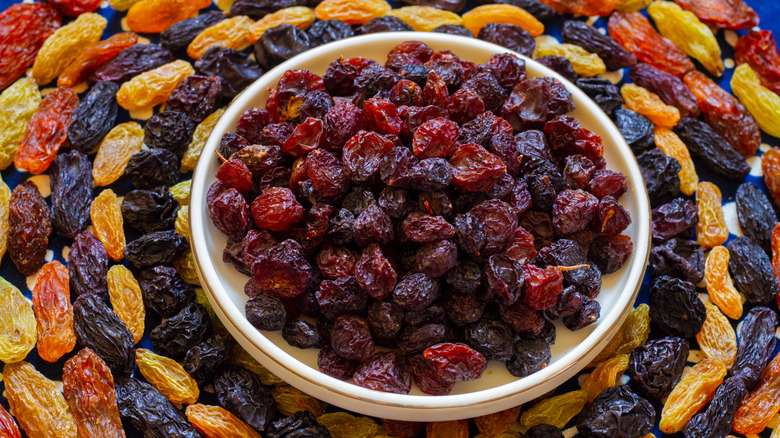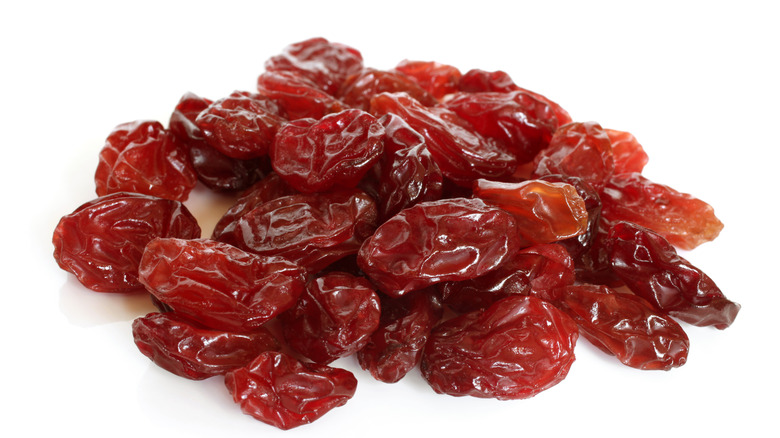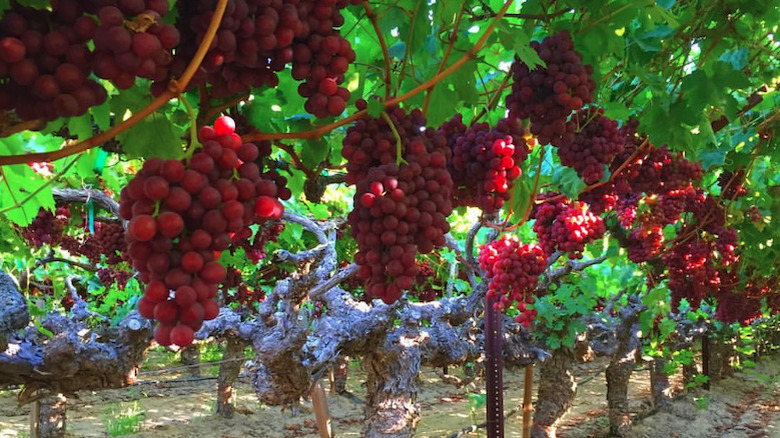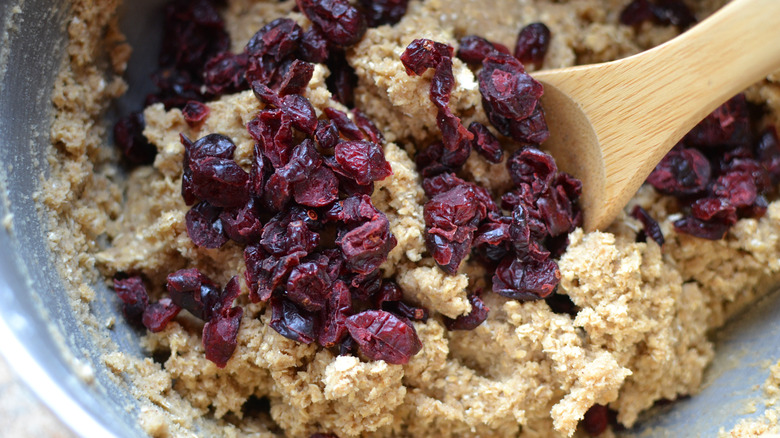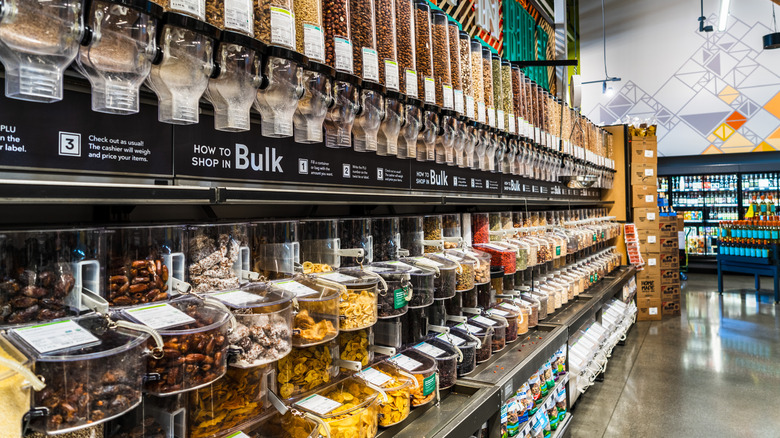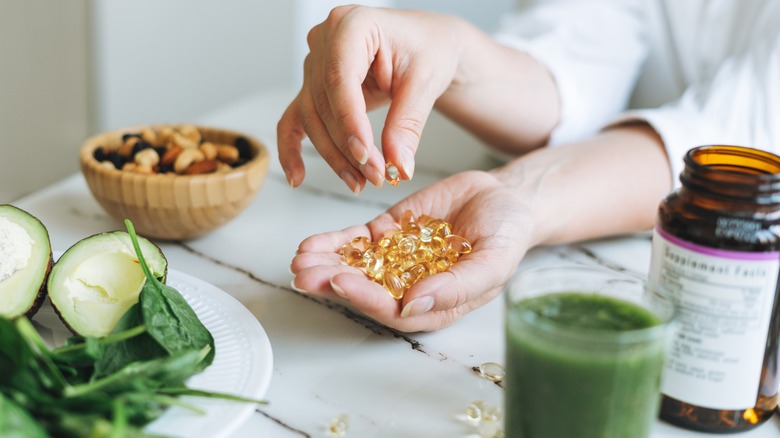What Makes Flame Raisins Unique?
All raisins are not created equal. That's because raisins are made from grapes and, as anyone who's ever perused the varieties of grapes in a grocery store or even casually studied wine production knows, grapes come in myriad shapes, sizes, and flavor profiles — and so do raisins since they're essentially dried grapes. To understand raisins, and specifically what makes flame raisins unique, we need to know a bit about the grapes they're made with.
Let's start at the beginning: The term "grape" is a generic reference to Vitis vinifera, a genus comprising up to 80 varieties of grapes, including the flame seedless grapes that, when sun-dried, become flame raisins. Also known simply as red raisins, flame raisins are prized for their extra sweet flavor profile and attractive red color. They are also the largest of the most commonly available varieties of raisins.
According to the University of California Division of Agriculture and Natural Resources, flame seedless grapes were developed by researchers at the USDA's Agricultural Research Center in Fresno, California. John Kovacevich, a fruit grower in Arvin, California, about 100 miles north of Los Angeles, produced the first commercial crop in 1973. A hybrid cultivar, flame grapes, and subsequently flame raisins, contain elements of other grape varieties including cardinal, Thompson seedless, red malaga, and muscat.
What are flame raisins?
So what are flame raisins? Simple answer: They're sun-dried flame grapes. While flame grapes are bright red, flame raisins are a bit more muted — but still noticeably red. Specialty Produce describes flame grapes as a seedless variety with a noticeably sweet flavor that, when dried, result in plump, rich raisins. International food ingredient company, Khoshbin Group, says flame raisins, aka red raisins, are similar in taste and texture to more common black raisins which are produced from Thompson seedless grapes.
So, how do they stack up against the competition? Khoshbin Group did a comparison to showcase the difference among the most common varieties of raisins, including black, golden, green, currants, and flame. Of all the varieties, flame raisins (made from flame grapes) are most similar to black raisins (made from Thompson seedless grapes.) Both varieties are air-dried; key differences include flame raisins slightly sweeter flavor profile and larger size. Golden raisins, also made from Thompson seedless grapes, dry in a dehydrator to protect their color. The result is a light fruity flavor. Green raisins are yet another version of raisins made from Thompson seedless grapes. They are shade-dried to produce a sweet-with-a-tang flavor. Finally, currants — the smallest among common raisin varieties, are sweetly tart.
History and production of flame raisins
California Raisins links the introduction of raisins in North America to 1873 when a massive heat wave in California's San Joaquin Valley left the grape crop shriveled on the vine. Savvy growers looked at the ruined crop and saw opportunity, heralding the start of California's raisin industry. In subsequent years, they began intentionally harvesting grapes a little early, then setting them out to dry in the sun. Voilà! California's sun-dried raisin industry was born — but it took another hundred years for flame raisins to join the ranks of "nature's candy."
While nature does most of the work when it comes to producing raisins, they still have to be harvested and packaged. According to How Products Are Made, with the exception of mechanical innovations, the process hasn't changed much over the years. The grapes for varieties that are air-dried, like flame and black raisins, are picked in the late summer and laid on paper trays to dry. When water content is reduced to about 15% — it takes two to four weeks — the paper trays of dried fruit are rolled up and transported to a processing facility where they are cleaned, inspected, and packaged for distribution.
Cooking with flame raisins
Sun-dried flame raisins on their own are a sweetly satisfying snack, but they're also a great ingredient to have tucked away in the cupboard. They come in handy anytime you want to add a pop of color and sweetness to baked goods including bread, scones, cookies, and muffins. They also make a nice addition to trail mix and granola. Country Products suggests adding a touch of cinnamon to enhance their natural sweetness. And since they're packed with nutrients and flavor, Healthline suggests tossing a handful of raisins into salads, oatmeal, and yogurt.
Looking for inspirational ideas to showcase flame raisins? California Raisins' take on kaiserschmarrn, an Austrian version of pancakes, may be the place to start. Served as breakfast or as a sweet snack, kaiserschmarrn is a chopped or shredded pancake dusted with confectioner's sugar and topped with plum-raisin compote. Or just get creative: Because flame raisins (made from flame grapes) and regular raisins (made from Thompson seedless grapes) are similar in flavor and texture, they can be used interchangeably in most recipes.
How to buy and store flame raisins
Despite their popularity, flame raisins may be difficult to find in a grocery store, less commonly available than black raisins or golden raisins. Sun-Maid's Mixed Jumbo Raisins is a colorful blend of golden raisins and flame raisins, but the official description of the product — labeling it a "fancy blend" — presents a clue as to why finding flame raisins, on their own, may require a bit of sleuthing.
That said, flame raisins are available year-round. Don't get discouraged. Take a close look at the bulk display of dried fruits, nuts, and grains at your local grocery story. While all varieties of raisins have a long shelf life, they are best when they are plump and pliable as opposed to hard and dry. Walk on by if you detect a sour or rotten smell, and beware of mold. Although it's uncommon in dried fruit, raisins stored in a too-humid environment can become a fertile ground for fungal growth. If your sleuthing turns up empty, there's always online shopping. Nuts.com lists the price of flame raisins at $6.99 per pound before delivery cost.
When it comes to storing flame raisins, follow the same guidelines you would for any variety of raisins. To prevent hardening, Food Hero advises storing raisins in an air-tight container set in a cool, dark, and dry location for up to six months. If, despite your best efforts, the raisins do harden, try soaking them in hot liquid for a few minutes.
Flame raisins' nutritional value
When it comes to nutritional value, flame (or red) raisins align closely with other varieties of raisins. According to the USDA, ¼-cup of loosely packed red raisins contains 130 calories. Red raisins have zero grams of fat, 31 grams of carbohydrates, two grams of fiber, and one gram of protein. They also contain 20 mg of protein and 1.08 mg of iron, and they supply 9% of the USDA daily recommendation of potassium and 2% of the USDA daily recommendation of vitamin A.
What does that mean? Let's start with calories. For a 150-pound person, it takes about 30 minutes of walking at a moderate pace, give or take, to burn 130 calories. At 31 grams of carbohydrates, a ¼-cup serving of loosely packed raisins provides about 10% of the USDA recommendation for daily carbohydrate intake. That's not necessarily a bad thing because, according to VeryWellFit, most of the natural sugar in raisins is fructose which has a lower glycemic index — the measurement for how a specific food affects blood sugar — than glucose. Raisins are also rich in the antioxidants that counteract the free radicals that may open the door to cancer and other diseases.
While raisins are generally considered a healthy snack, going overboard can have unpleasant repercussions. For example, Medical News Today cites the soluble fiber content of raisins, warning that consuming high quantities can lead to cramps, gas, and bloating, and diarrhea.
